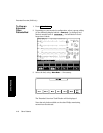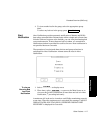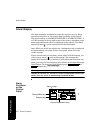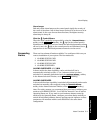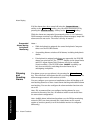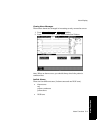
Alarm Display
5-4 Alarm Functions
Alarm Functions
If all the alarms have been turned off using the
softkey or the hardkey, they can all be turned back on by
pressing the softkey or the hardkey.
While the alarms are suspended (permanently or for 1, 2 or 3 minutes),
INOP messages continue to be displayed but alarm messages, lamps and
alarm tones are not active. The nurse call relay is inactive.
Suspended
Alarms during
Arrhythmia
Monitoring
Notes—
• While Arrhythmia is assigned, the central Arrhythmia Computer
takes over the ECG/HR alarms.
• Suspending Alarms switches off all alarms, including Arrhythmia
alarms.
• If Arrhythmia is assigned and alarms are suspended, the ECG/HR
alarms are switched off. The Softkey in the Alarm Limits
and ECG Adjust Alarms Task Windows will not be available
(inactive softkey). The ECG/HR alarm capability can
only be reactivated by switching the main Alarms on, or
unassigning Arrhythmia.
Silencing
and
Resetting
Alarms
If an alarm occurs you can silence it by pressing the
key. This will silence ALL alarms that are occurring at that moment. The
alarm messages numeric will continue to blink.
You can configure your system on installation to have all latching or all
non-latching alarms or to have visual alarms latching and audible alarms
non-latching. You can also configure the alarm reminder function to be
on or off.
Note—We recommend that you configure latching alarms for your
monitor for Intensive Care use. All monitors within a unit should have
the same alarm configuration!
Note—Audible alarm indications broadcast over the Philips monitoring
network (SDN) are always treated like visual alarms on the central
station or remote systems (even if the bedside monitor is configured
differently).
Suspend Alarms
Suspend
SwitchOn Alarms
Suspend
ON/OFF
ON/OFF
Silence/Reset





